人教版高中英语选修八 Unit5 Meeting your ancestors using language-listening and speaking课件(共31张)
文档属性
| 名称 | 人教版高中英语选修八 Unit5 Meeting your ancestors using language-listening and speaking课件(共31张) | 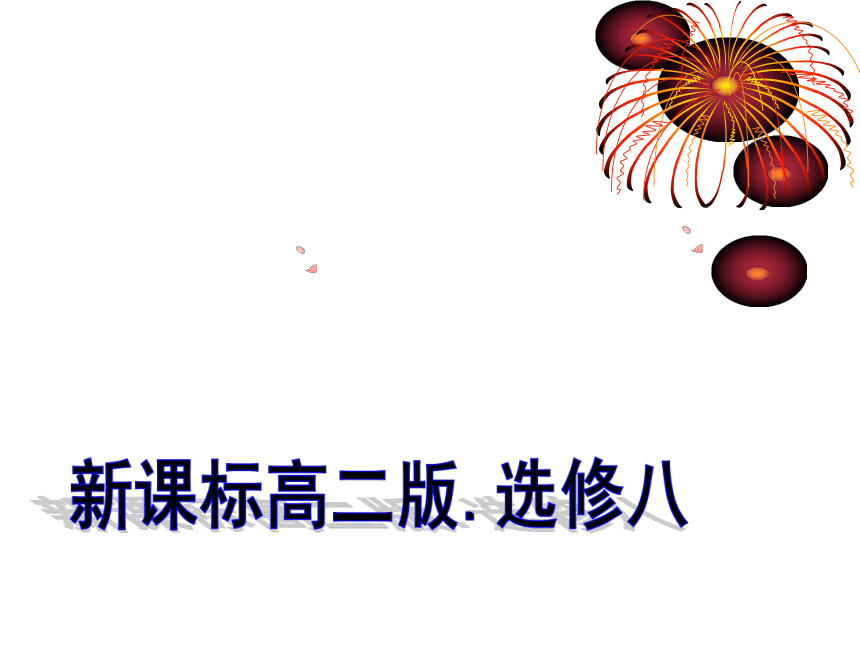 | |
| 格式 | zip | ||
| 文件大小 | 2.2MB | ||
| 资源类型 | 教案 | ||
| 版本资源 | 人教版(新课程标准) | ||
| 科目 | 英语 | ||
| 更新时间 | 2019-03-04 21:49:42 | ||
图片预览


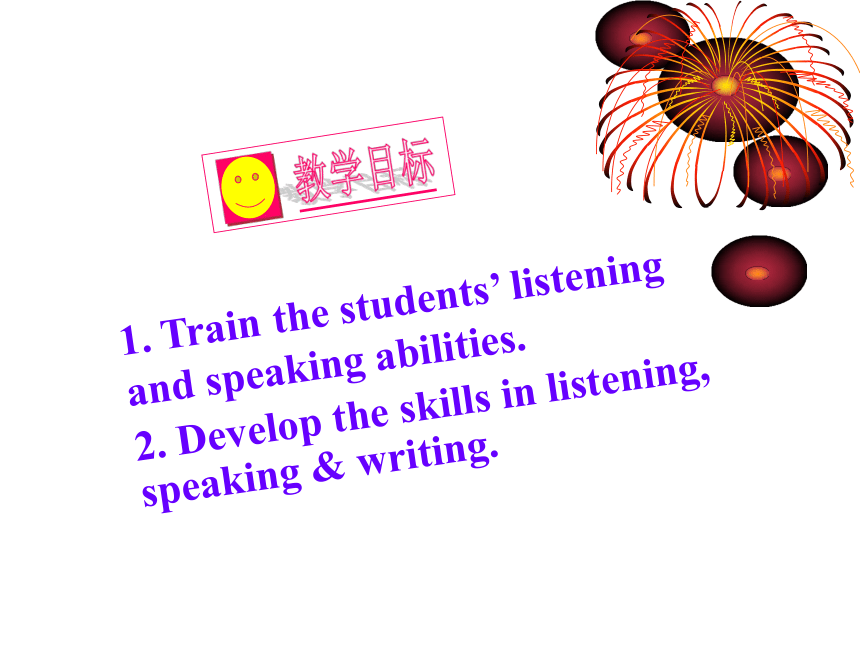
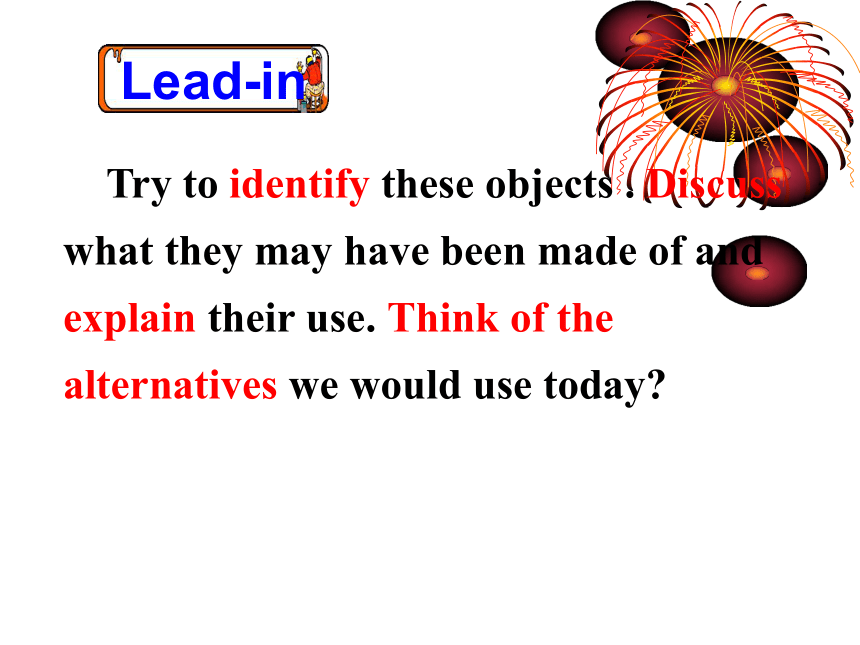





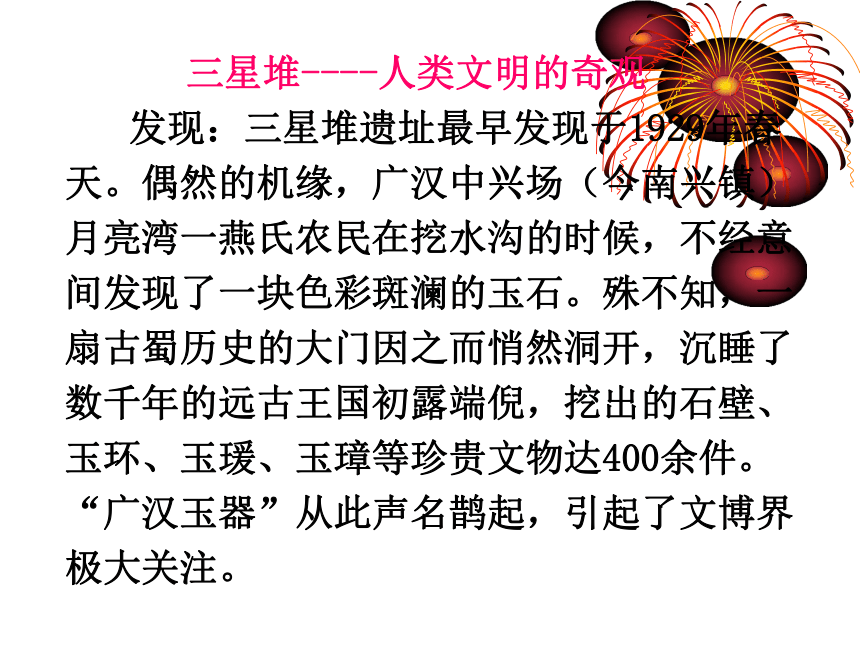
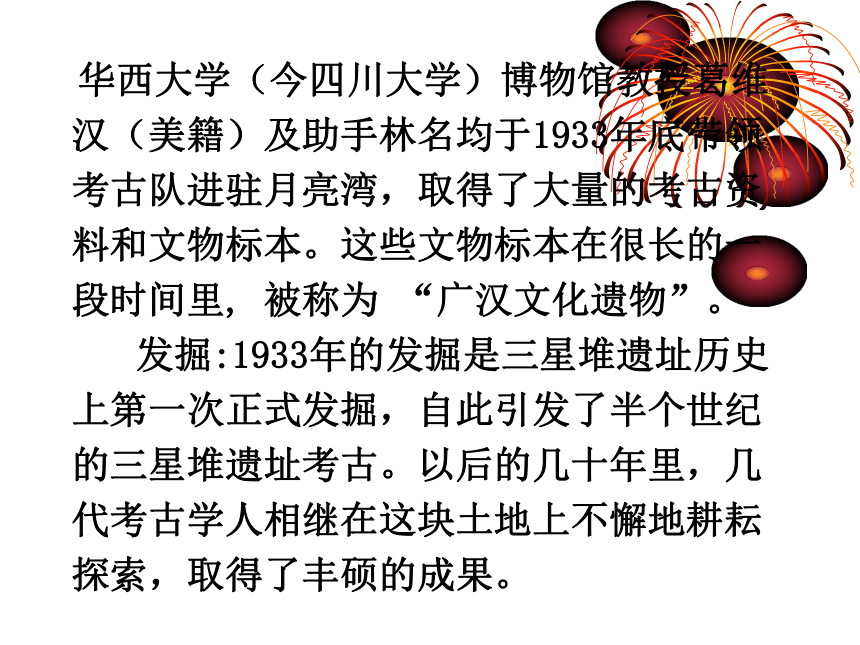

文档简介
课件31张PPT。新课标高二版.选修八Unit 5Meeting your ancestorsUsing language – listening
and discussing1. Train the students’ listening and speaking abilities.
2. Develop the skills in listening, speaking & writing. Try to identify these objects . Discuss what they may have been made of and explain their use. Think of the alternatives we would use today?Lead-inclay
lampChinese chimesclay/
potteryto light
the houseelectric
lightmetal, possibly bronze or brassto provide musicxylophonestone/ jade axe stone/ jade to chop woodchain sawdeath maskgoldto cover the face of the pharaoh after his death none Look at the beautiful pictures. They were found during an excavation in the Sanxingdui Ruins and than watch the movie.Speaking三星堆----人类文明的奇观
发现:三星堆遗址最早发现于1929年春天。偶然的机缘,广汉中兴场(今南兴镇)月亮湾一燕氏农民在挖水沟的时候,不经意间发现了一块色彩斑澜的玉石。殊不知,一扇古蜀历史的大门因之而悄然洞开,沉睡了数千年的远古王国初露端倪,挖出的石壁、玉环、玉瑗、玉璋等珍贵文物达400余件。 “广汉玉器”从此声名鹊起,引起了文博界极大关注。 华西大学(今四川大学)博物馆教授葛维汉(美籍)及助手林名均于1933年底带领考古队进驻月亮湾,取得了大量的考古资料和文物标本。这些文物标本在很长的一段时间里, 被称为 “广汉文化遗物”。
发掘:1933年的发掘是三星堆遗址历史上第一次正式发掘,自此引发了半个世纪的三星堆遗址考古。以后的几十年里,几代考古学人相继在这块土地上不懈地耕耘探索,取得了丰硕的成果。 东、西、南三面城墙的确认,大型宫殿遗址的发掘清理以及数以万计文物的出土,尤其是1986年7月至9月间,两个大型祭祀坑的相继发现,上千件文物精品洋洋洒洒地横空出世,震惊了全国轰动了全世界。
根据半个多世纪以来考古调查发掘资料的汇集,可将三星堆遗址的文化层次分为新石器时代和夏、商、周四个大的时代。在这四个时代中,小平底陶罐、圈足陶豆、高柄豆等典型器物在不同时期的形制, 基本上反映出这一文化连续发展的关系及连贯性。
大型青铜立人像、纵目人面像、八鸟四牛尊、金杖、戴金面罩青铜人头像、青铜神树等。三星堆文物作为罕见的、集群展现的人类上古史奇珍,有许多器物是世界上独一无二的。 三星堆青铜器每一件都有其独特之处,其光怪陆离、奇异诡谲的造型不愧是稀世之珍。 bronze sacred treebronze animal-face imagebird-shaped ornamentpottery pot Listening and Speaking 1. Listen to the Part1 of the tape and try to understand “the wastepaper basket” diagram on the right and fill in the layers. yogurt potsorange skinwastepaperused envelopes1. Listen to the Part2 of the tape and complete the passage below. It uses radioactivity to measure the amount of
________ in living things. The________ in
a dead body___________ at a _________ rate.
We know long that takes, so we can measure
the amount of ________and _________how old
a bone is.carboncarbondisappearsfixedcarbonwork out Note: The age of the building depends on the number of layers it is resting on. The more layers, the more recent the building. Answer key for Exercise 3: The oldest building is B because it has no layers underneath it.
The second oldest building is C because it has one layer underneath it.
The most recent building is building A. It has two layers underneath. ZH: How can you tell me how old the bones
are when you find them?LISTENING TEXT(P42)DATING METHODSZhou Heping has come to ask the archaeologist, Richard Leakey, how he dates the bones he finds.Part 1RL: There are two main ways: the first uses layers in the ground and the second uses the radiocarbon dating.
ZH: I see. How does the layer method work?
RL: Well, look at the diagram in your book. Think of a wastepaper basket. When you came into work, you ate an orange and threw the orange skin into it. That’s layer number1. Later somebody threw some yogurt pots into it. That’s layer numver2.ZH: Oh yes, and then I threw some paper into it. So that’s layer number3.
RL: Yes, and finally someone threw away some used envelopes. So how many layers are there in this wastepaper basket.ZH: There are four.
RL: Which layer is the first and therefore the oldest?
ZH: The orange skin.
RL: And which is the last and therefore the most recent?
ZH: Of course – the used envelopes. I see how it works now. But how does it help?RL: Well, layers of soil are produced at different times like the layers in your wastepaper basket. Each time people live some where, they make a layer in the soil. If they live there for a long time, they make a lot of layers. Each layer has a different colour and texture which we use to find out how old it is.
ZH: How splendid! ZH: Now what about radiocarbon dating?
RL: This is more scientific. It uses radioactivity to measure the amount of carbon in living things. The carbon in a dead body disappears at a fixed rate. We know how long that takes, so we can measure the amount of carbon and work out how old a bone is.
ZH: That’s very clever. Is it accurate too?
Part 2 RL: There are some problems with very old bones, so you are always given two dates.
ZH: How does that work?
RL: Well the date for a bone may be between 9,900 years and 10,100 years old. ZH: I see! How old are the bones in the Zhoukoudian caves?
RL: They are between 250,000 and 40,000 years old.
ZH: Perhaps we can go and visit the site together sometime?
RL: Of course. Whenever you like! 1. Find some information about Zhoukoudian Caves.
2. Do the Exercise 3 on Page 45.Homework
and discussing1. Train the students’ listening and speaking abilities.
2. Develop the skills in listening, speaking & writing. Try to identify these objects . Discuss what they may have been made of and explain their use. Think of the alternatives we would use today?Lead-inclay
lampChinese chimesclay/
potteryto light
the houseelectric
lightmetal, possibly bronze or brassto provide musicxylophonestone/ jade axe stone/ jade to chop woodchain sawdeath maskgoldto cover the face of the pharaoh after his death none Look at the beautiful pictures. They were found during an excavation in the Sanxingdui Ruins and than watch the movie.Speaking三星堆----人类文明的奇观
发现:三星堆遗址最早发现于1929年春天。偶然的机缘,广汉中兴场(今南兴镇)月亮湾一燕氏农民在挖水沟的时候,不经意间发现了一块色彩斑澜的玉石。殊不知,一扇古蜀历史的大门因之而悄然洞开,沉睡了数千年的远古王国初露端倪,挖出的石壁、玉环、玉瑗、玉璋等珍贵文物达400余件。 “广汉玉器”从此声名鹊起,引起了文博界极大关注。 华西大学(今四川大学)博物馆教授葛维汉(美籍)及助手林名均于1933年底带领考古队进驻月亮湾,取得了大量的考古资料和文物标本。这些文物标本在很长的一段时间里, 被称为 “广汉文化遗物”。
发掘:1933年的发掘是三星堆遗址历史上第一次正式发掘,自此引发了半个世纪的三星堆遗址考古。以后的几十年里,几代考古学人相继在这块土地上不懈地耕耘探索,取得了丰硕的成果。 东、西、南三面城墙的确认,大型宫殿遗址的发掘清理以及数以万计文物的出土,尤其是1986年7月至9月间,两个大型祭祀坑的相继发现,上千件文物精品洋洋洒洒地横空出世,震惊了全国轰动了全世界。
根据半个多世纪以来考古调查发掘资料的汇集,可将三星堆遗址的文化层次分为新石器时代和夏、商、周四个大的时代。在这四个时代中,小平底陶罐、圈足陶豆、高柄豆等典型器物在不同时期的形制, 基本上反映出这一文化连续发展的关系及连贯性。
大型青铜立人像、纵目人面像、八鸟四牛尊、金杖、戴金面罩青铜人头像、青铜神树等。三星堆文物作为罕见的、集群展现的人类上古史奇珍,有许多器物是世界上独一无二的。 三星堆青铜器每一件都有其独特之处,其光怪陆离、奇异诡谲的造型不愧是稀世之珍。 bronze sacred treebronze animal-face imagebird-shaped ornamentpottery pot Listening and Speaking 1. Listen to the Part1 of the tape and try to understand “the wastepaper basket” diagram on the right and fill in the layers. yogurt potsorange skinwastepaperused envelopes1. Listen to the Part2 of the tape and complete the passage below. It uses radioactivity to measure the amount of
________ in living things. The________ in
a dead body___________ at a _________ rate.
We know long that takes, so we can measure
the amount of ________and _________how old
a bone is.carboncarbondisappearsfixedcarbonwork out Note: The age of the building depends on the number of layers it is resting on. The more layers, the more recent the building. Answer key for Exercise 3: The oldest building is B because it has no layers underneath it.
The second oldest building is C because it has one layer underneath it.
The most recent building is building A. It has two layers underneath. ZH: How can you tell me how old the bones
are when you find them?LISTENING TEXT(P42)DATING METHODSZhou Heping has come to ask the archaeologist, Richard Leakey, how he dates the bones he finds.Part 1RL: There are two main ways: the first uses layers in the ground and the second uses the radiocarbon dating.
ZH: I see. How does the layer method work?
RL: Well, look at the diagram in your book. Think of a wastepaper basket. When you came into work, you ate an orange and threw the orange skin into it. That’s layer number1. Later somebody threw some yogurt pots into it. That’s layer numver2.ZH: Oh yes, and then I threw some paper into it. So that’s layer number3.
RL: Yes, and finally someone threw away some used envelopes. So how many layers are there in this wastepaper basket.ZH: There are four.
RL: Which layer is the first and therefore the oldest?
ZH: The orange skin.
RL: And which is the last and therefore the most recent?
ZH: Of course – the used envelopes. I see how it works now. But how does it help?RL: Well, layers of soil are produced at different times like the layers in your wastepaper basket. Each time people live some where, they make a layer in the soil. If they live there for a long time, they make a lot of layers. Each layer has a different colour and texture which we use to find out how old it is.
ZH: How splendid! ZH: Now what about radiocarbon dating?
RL: This is more scientific. It uses radioactivity to measure the amount of carbon in living things. The carbon in a dead body disappears at a fixed rate. We know how long that takes, so we can measure the amount of carbon and work out how old a bone is.
ZH: That’s very clever. Is it accurate too?
Part 2 RL: There are some problems with very old bones, so you are always given two dates.
ZH: How does that work?
RL: Well the date for a bone may be between 9,900 years and 10,100 years old. ZH: I see! How old are the bones in the Zhoukoudian caves?
RL: They are between 250,000 and 40,000 years old.
ZH: Perhaps we can go and visit the site together sometime?
RL: Of course. Whenever you like! 1. Find some information about Zhoukoudian Caves.
2. Do the Exercise 3 on Page 45.Homework
